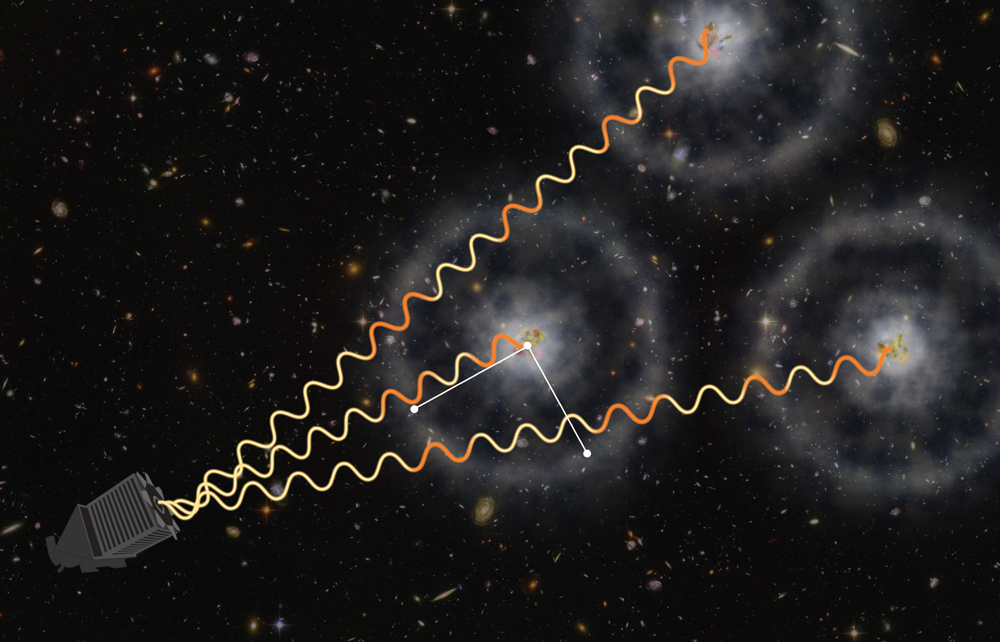Universe's Expansion Measured With Unprecedented Precision

Scientists studying more than 140,000 extremely bright galaxies have calculated the expansion of the universe with unprecedented accuracy.
The distant galaxies, known as quasars, serve as a "standard ruler" to map density variations in the universe. Physicists were able to extend their calculations almost twice as far back in time as has been previously accomplished.
Using the Baryon Oscillation Spectroscopic Survey (BOSS), two teams of physicists have improved on scientists' understanding of the mysterious dark energy that drives the accelerating universe. By nearly tripling the number of quasars previously studied, as well as implementing a new technique, the scientists were able to calculate the expansion rate to 42 miles (68 kilometers) per second per 1 million light-years with greater precision, while looking farther back in time. [8 Baffling Astronomy Mysteries]
Andreu Font-Ribera, of the U.S. Department of Energy's Lawrence Berkeley National Laboratory, led one of the two teams, while Timothée Delubac of EPFL, Switzerland, and France’s Centre de Saclay headed the other one. Font-Ribera presented the new findings in April at a meeting of the American Physical Society in Savannah, Georgia.
The new research "explores a region of the universe that was not explored before," Font-Ribera said.
Stretching the standard ruler
The expanding universe stretches light waves as they travel through it, a process astronomers refer to as redshifting. An object's physical distance from the observer depends on how quickly the universe is expanding.
Get the Space.com Newsletter
Breaking space news, the latest updates on rocket launches, skywatching events and more!
Baryon acoustic oscillations (BAOs) are sound waves imprinted in large structures of matter in the early universe. Competing forces of inward-pushing gravity and outward, heat-related pressure cause oscillations similar to sound waves in the baryonic, or "normal" matter in the universe.
Dark matter, which interacts with normal matter only gravitationally, stays at the center of the sound wave, while the baryonic matter travels outward, eventually creating a shell at a set radius known as the sound horizon.
Quasars, like other galaxies, are surrounded by dust. Light leaving galaxies streams through that dust, revealing the imprint of the BAOs. Studying this light allows researchers to map the distribution of quasars, as well as the gas in the early universe.
By using BOSS, the largest component of the third Sloan Digital Sky Survey, to map BAOs, scientists can determine how matter is distributed in the early universe. When it comes to measuring the expansion of the universe, BAOs serve as a "standard ruler."
"We think we know its size, and its apparent size depends on how far away it is," Patrick McDonald, of the Canadian Institute for Theoretical Astrophysics, said at the conference.
Previously, astronomers have used BAOs to measure the distances to galaxies in order to determine the distribution of mass in the universe, and thus the universe's expansion rate. But galaxies grow fainter at greater distances, so previous studies were limited to looking back only 6 billion light-years into the universe's 13.8-billion-year lifetime.
Font-Ribera and his team, which included McDonald, pioneered a method of measuring BAOs by using quasars, which are galaxies that are far brighter than normal due to the activity of a supermassive black hole at their center. As matter falls into the black hole, it grows extremely hot, radiating light at far brighter wavelengths and over farther distances than conventional galaxies. This allowed the scientists to measure the mass distribution of the universe out to 12 billion years.
Font-Ribera's research involved approximately 50,000 quasars. The new study published by Delubac's team reviewed nearly three times as many sources, more precisely calculating the expansion rate to an accuracy of 2.2 percent. [See images of dark matter in the universe]
"If we looked back to the universe when it was less than a quarter of its present age, we'd see that a pair of galaxies separated by a million light-years would be drifting apart at a velocity of 68 kilometers a second as the universe expands," Font-Ribera said in an accompanying press release.
"The uncertainty is plus or minus only a kilometer and a half per second."
The expanding universe
In the early twentieth century, astronomer Edwin Hubble determined that the galaxies in the universe are all moving away from the Milky Way because the universe is expanding. Further studies led astronomers to conclude that the rate of expansion is speeding up rather than slowing down.
McDonald compared the process to a ball thrown in the air.
"Acceleration is like you throw the ball up, and it starts going up faster and faster," McDonald said. "No normal attractive gravity will do that."
Astronomers determined that an unseen force, dubbed "dark energy," causes the acceleration. McDonald calls dark energy a "placeholder" because scientists aren't certain what, precisely, it is.
"To me, it seems quite possible that it's related to some fundamental hole in our understanding of physics," he said.
In order to patch that hole, scientists must continue to learn more about dark energy, including its role in accelerating the expansion of the universe.
Follow us @Spacedotcom, Facebook and Google+. Original article on Space.com.
Join our Space Forums to keep talking space on the latest missions, night sky and more! And if you have a news tip, correction or comment, let us know at: community@space.com.

Nola Taylor Tillman is a contributing writer for Space.com. She loves all things space and astronomy-related, and enjoys the opportunity to learn more. She has a Bachelor’s degree in English and Astrophysics from Agnes Scott college and served as an intern at Sky & Telescope magazine. In her free time, she homeschools her four children. Follow her on Twitter at @NolaTRedd









